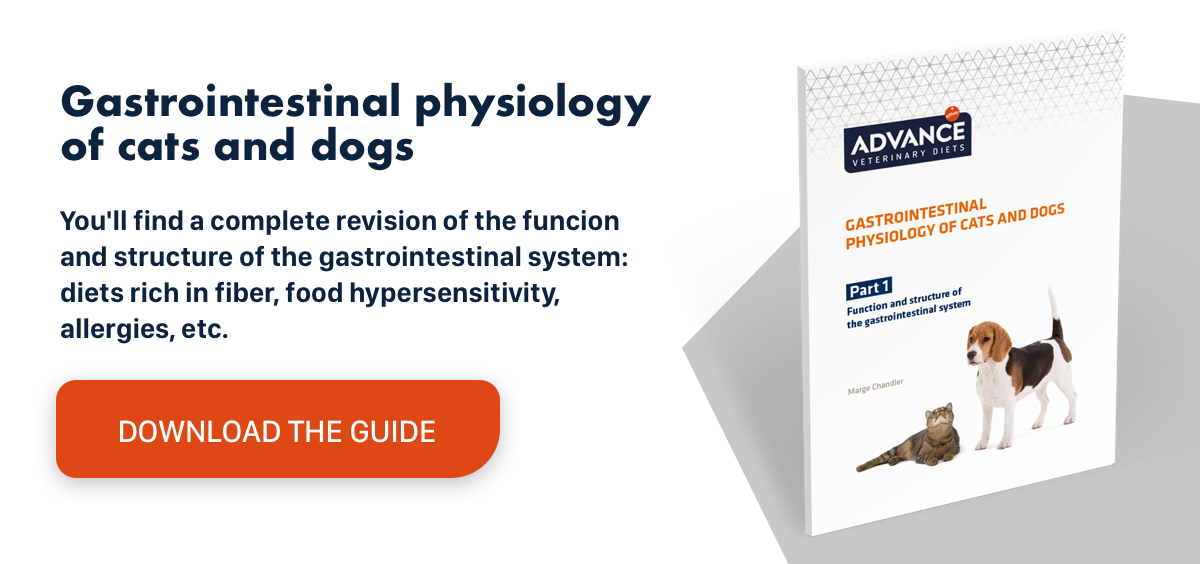Weight loss in elderly dogs
Introduction
A dog’s body condition changes throughout the various stages of life. People generally believe that older dogs tend to be overweight; however, evidence indicates that older dogs are more likely to be underweight than overweight.1
The percentage of senior dogs with a tendency to be underweight is not known, but in human medicine it is estimated that 65% of elderly patients are affected.2 In any case, being underweight is not always a sign of disease, so not all cases require specific attention. But if the patient is excessively underweight and progressively losing more weight (unintentionally) and body condition score, it is probably a sign of serious systemic disease, which requires a specific approach and suitable treatment. Pronounced loss of lean body mass is associated with increased morbidity and mortality.1
There is no agreed criterion as to what extent of weight loss is considered clinically significant, yet if it is greater than 5% in less than a year, it probably requires a specific diagnostic study.3
Clinical evaluation of weight loss in elderly dogs
The first step when assessing weight loss in elderly dogs is to measure its weight and body condition and compare the data against any relevant information in their medical history, if available. Determine the patient’s caloric intake and type of diet, because in principle, a dog that has gone from an appropriate body condition to being underweight probably suffers from a dietary imbalance or the malabsorption or poor use of nutrients.3 Consequently, it is important to bear in mind that there is no need to restrict protein intake in the diet of healthy elderly dogs.1
Patients with malnutrition due to a digestive or absorption disorder may have the same or a greater appetite, while the presence of hyporexia or anorexia suggests the existence of a serious systemic disease. In addition, it is important to differentiate between dogs that want to eat, but cannot because of a problem picking up, chewing or swallowing food, and ones that show no interest in their food.
The list of the possible causes of weight loss in elderly dogs should include, but is not limited to: gastrointestinal and non-gastrointestinal tumours, dental disease, chronic enteropathies, chronic pancreatitis, diabetes, hyperparathyroidism, bacterial or fungal infections, heart failure secondary to dilated cardiomyopathy or mitral valve disease, chronic kidney disease and neurological disorders.3
As with any other condition, a full physical examination should be performed, as the cause may be diagnosable (as in the case of severe oral disease), or it may provide important information about the diagnostic tests required (ultrasound after palpation of an abdominal mass). The next step after the physical exam is to obtain blood and urine samples for a complete blood count, biochemistry and urinalysis, and to perform routine imaging tests (X-rays/ultrasound).
The order in which the tests should be done will depend on the findings of the physical exam. The tests may help establish the cause of the dog’s weight loss, but not always. In human medicine, the cause cannot be established in up to 30% of patients with unintentional weight loss. Regular monitoring and follow-up are recommended in these cases.3
.jpg)
Treatment
The treatment of weight loss in elderly dogs consists of controlling the underlying cause and establishing adequate nutritional support.
- It is a good idea to increase the palatability of the diet in patients with hyporexia. The more appetising a dog’s food is, the more likely it is to eat it. Lots of dogs that are used to dry diets tend to show more interest in wet food. Another option to improve palatability is to increase the food’s fat or protein content, provided this is not contraindicated by an underlying disease.
- If the gastrointestinal tract is functional, but the patient’s energy requirements are not being met, consider assisted feeding.
- Another option is the use of appetite stimulants, and although none of those marketed in Spain have proven to be effective in groups of controlled patients. Capromorelin (3 mg/kg/24 hours) is a ghrelin agonist registered in the USA as an appetite stimulant for dogs. There are no data available on its efficacy when used for more than 4 days, but the apparently broad safety profile means it has been recommended for chronic use.4
Conclusions
Veterinary surgeons often notice some elderly dogs they have looked after since they were puppies lose weight and become evidently thinner. Before deciding if it is a natural, physiological process or whether various diagnostic tests are required, it is important to quantify the potential weight loss and changes in the animal’s body condition. Furthermore, in the author’s opinion, it is vital to estimate the patient’s caloric intake correctly, as most owners are unaware how much their pet eats each day.
